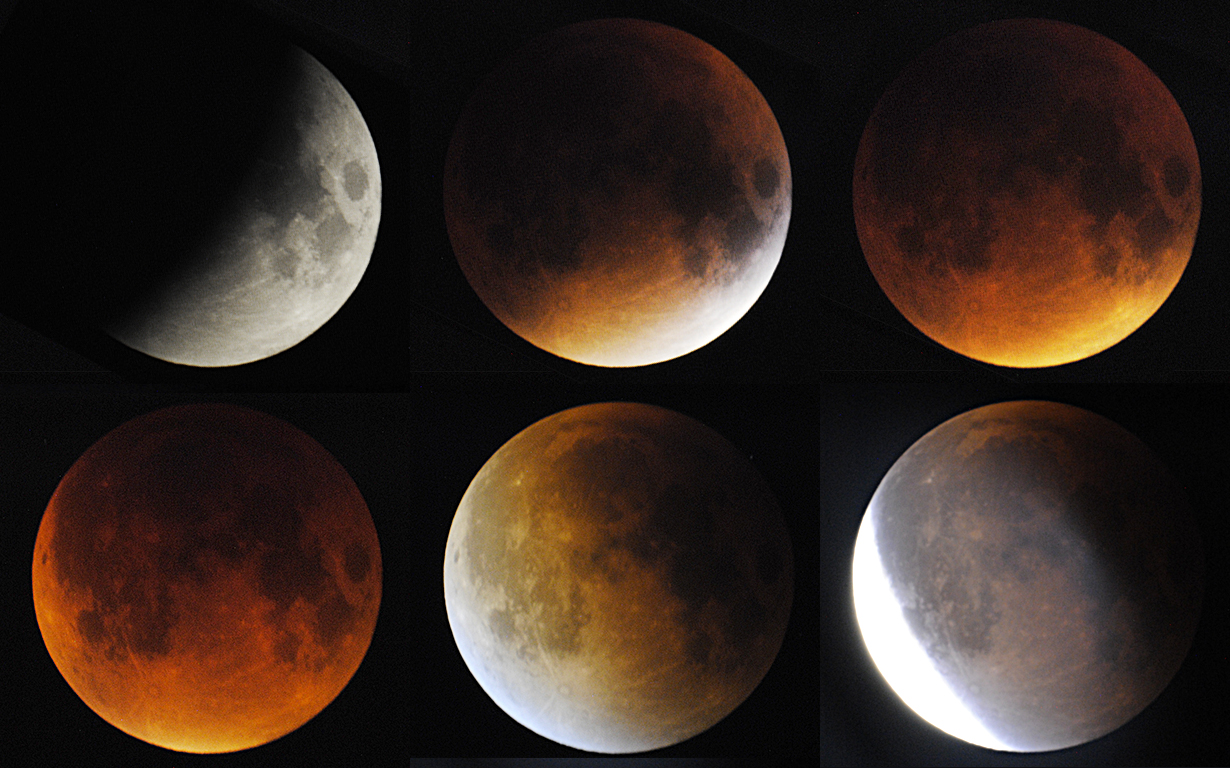28 September 2015 UT
Tucson, Arizona
Glenn Schneider
(Steward Observatory and the Department of Astronomy, The University of Arizona)

On
Sunday evening September 27, 2015, the Moon began a transit through the
Earth's umbral shadow at 6:07 PM MST (see
diagram
from Fred Espenak),
but would not be visible until two minutes later from Tucson, Arizona,
where the ingress phase of the total lunar eclipse was just beginning
at local moonrise. From my house, however, the early part of partial
ingress phase was obscured by the Rincon mountains to the east. The
partially eclipsed Moon was first seen later in twilight as it ascended
above the mountain peak as I watched out the open door of my garage
with ingress about 40% complete; top left photo, a few minutes after
the Moon broke free from behind some scrubby trees at about 6:40 PM
MST. The few isolated thin clouds toward the east in early twilight,
that did not hamper the lunar view, dissipated quickly with nightfall
and the sky was perfectly clear for the rest of the
eclipse.
A few photos, following the first one mentioned above (with time incrementing from top left to bottom right) captured the moon's traverse through the Earth's umbra from a few minutes before totality (top/middle) to a minutes after totality (bottom/middle). The moon in total eclipse, soon before and after its deepest penetration into the Earth shadow, is shown in between in the (top, right) and (bottom, left) photos. During that time, Moon took on a very deep and almost ashen coppery color, and faded almost into complete obscurity on the north (upper) side of the lunar disk against an eerily dark "full moon" sky.
The last photo (bottom, right) is a deep exposure after totality where the returning bright portion of the Moon is overexposed to reveal a bluish tinge of coloration can be seen along the interior edge of the remaining arc of the Earth's shadow and fading beyond into the still reddened area of the lunar surface. From nasa.science.gov/science-news: "The source of the turquoise is ozone. Eclipse researcher Dr. Richard Keen of the University of Colorado explains: "During a lunar eclipse, most of the light illuminating the moon passes through the stratosphere where it is reddened by scattering. However, light passing through the upper stratosphere penetrates the ozone layer, which absorbs red light and actually makes the passing light ray bluer." This can be seen, he says, as a soft blue fringe around the red core of Earth's shadow.
Photo details: The images above were taken with a vintage clock-driven (tracking) Questar 3-1/2 telescope (f/14 back focus) with a Nikon D3000 camera. ISO 1600. 1/50 sec for the initial partial eclipse photo, 1 sec (each) for middle column frames transitioning to totality, and 4 sec each (yes, that's right; its f/14 after all!) for the two "copper" images flanking deepest eclipse. The final partial frame revealing the bluish tinge in the periphery of the umbral shadow was a 1.5 sec exposure.
WOW! TWO TLEs in one year with clear skies from home! (HERE is the other). And... yet ANOTHER (HERE) only a year prior! What a "hat trick"!
A few photos, following the first one mentioned above (with time incrementing from top left to bottom right) captured the moon's traverse through the Earth's umbra from a few minutes before totality (top/middle) to a minutes after totality (bottom/middle). The moon in total eclipse, soon before and after its deepest penetration into the Earth shadow, is shown in between in the (top, right) and (bottom, left) photos. During that time, Moon took on a very deep and almost ashen coppery color, and faded almost into complete obscurity on the north (upper) side of the lunar disk against an eerily dark "full moon" sky.
The last photo (bottom, right) is a deep exposure after totality where the returning bright portion of the Moon is overexposed to reveal a bluish tinge of coloration can be seen along the interior edge of the remaining arc of the Earth's shadow and fading beyond into the still reddened area of the lunar surface. From nasa.science.gov/science-news: "The source of the turquoise is ozone. Eclipse researcher Dr. Richard Keen of the University of Colorado explains: "During a lunar eclipse, most of the light illuminating the moon passes through the stratosphere where it is reddened by scattering. However, light passing through the upper stratosphere penetrates the ozone layer, which absorbs red light and actually makes the passing light ray bluer." This can be seen, he says, as a soft blue fringe around the red core of Earth's shadow.
Photo details: The images above were taken with a vintage clock-driven (tracking) Questar 3-1/2 telescope (f/14 back focus) with a Nikon D3000 camera. ISO 1600. 1/50 sec for the initial partial eclipse photo, 1 sec (each) for middle column frames transitioning to totality, and 4 sec each (yes, that's right; its f/14 after all!) for the two "copper" images flanking deepest eclipse. The final partial frame revealing the bluish tinge in the periphery of the umbral shadow was a 1.5 sec exposure.
WOW! TWO TLEs in one year with clear skies from home! (HERE is the other). And... yet ANOTHER (HERE) only a year prior! What a "hat trick"!